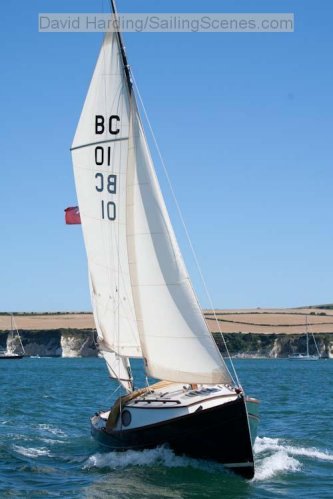There were a couple of interesting comments on a previous post about the engine arrangement in Daisy Grace and I think it is worth looking at in some detail. I think the Swallowboats solution to the problem is one of the best I have seen, and it sold the basic Bayraider design to me.
I used to have a Drascombe Dabber and I loved it, but it was the only yawl rigged Drascombe I liked. It faced the usual problem of how do you get around the conflict of mizzen mast/rudder/tiller/outboard engine position. The Dabber solution was to mount the engine to one side, the very small mizzen on the transom on the other side and the rudder on the transom, with a long tiller that just cleared the engine.
The bigger Drascombe yawls adopted an arrangement that I always felt I could never have lived with. The engine right at the back, where it is hard to reach to tilt up and sticks out the back when tilted, not pretty. The mizzen in the middle in front of the engine, which is good. But then the rudder is in front of the mizzen mast, sticking down through the bottom of the boat. In a design meant for sailing in shoal waters I just do not understand this arrangement. You can see in this photo how the whole steel rudder assembly has had to be hauled up when going aground. How can this be a good idea? I have heard Drascombe sailors extolling all the different ways you can steer in shallow water with paddles and oars. I like steering with the rudder. If you get caught drying out with the rudder down, or worse, have a kick up blade which kicks up and thus jambs the rudder under the boat, you are in real trouble. I really don't like this arrangement.
The Swallowboat Storm series have a curious solution, with the tiller behind the mizzen mast. All users (and the builder) assure me it works perfectly well. I have never tried it but it looks weird to me.
The Bayraider/cruiser solution is based on the massive stainless steel rudder stock. This supports the tiller over the engine, but then dips down below a stern bridge-deck which supports the mizzen and then forms the rudder head outside the transom. The only opening in the transom is a small oval to allow the stainless steel tube to pass through. This allows the rudder to be on the back, the mizzen to be inboard on the centreline, the tiller in front of the mizzen mast, above the engine and the engine to be able to be tilted right up, out of the water and inside the boat.
The only problem I have with this arrangement is that when the engine is tilted, it does protrude into the cockpit. Not a problem with one or two aboard, but it does make it a bit cramped with three or four. A smaller engine takes up less room. I have got a 6HP outboard. A little 2.5HP Honda is more than adequate for the vast majority of situations. If you can be bothered you could lift it off and put it in the locker.
You could just leave the engine down but that has a few problems. It does increase drag, a lot. It makes it harder to steer and if you are a dumb as me you forget to tilt it up on a drying mooring. Fortunately I was on such soft mud it just pushed down into it. The best boat I have seen with a fixed down outboard was my old Winkle Brig. This used a deep GRP skeg to protect and streamline the submerged leg. It slowed the boat down but did mean you had a remarkably large cockpit for a 16ft boat with a three berth cabin.
Subscribe to:
Post Comments (Atom)







No comments:
Post a Comment